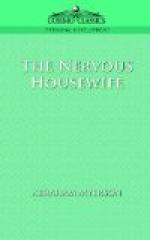All the cynics and epigram makers in the world agree that love ends with marriage, and this not only in modern times but even back into those days of the French Court of Love, when Margaret de Valois decided that the lover had more claims than the husband. Romance dies with marriage is the plaint of poet and novelists; the charm of woman disappears with her mystery, with possession. And the typical humorist speaks of the curl papers and kimono of the wife, the snores and unshaven beard of the husband. “Familiarity is the death of passion” is the theme of countless writers who bemoan its passing in the matrimonial state.
How much harm the romantic tales have done to marriage and the sober-satisfying everyday life, no one can estimate, no one can overestimate. Romanticism, which extols sex as the prime and only thing of life, prudery which closes its eyes to it and makes sour faces, need special places in Dante’s Inferno. Neither has dealt with reality,—reality, which is satisfying and pleasant unless examined with the prejudices instilled by the hypersexual romance writer and the perverted sexuality of the prude.
Nevertheless that two people brought up entirely differently, and having different attitudes towards love and life, should come into sharp conflict is to be expected. Further, that disillusionment follows after the excitement and heightened expectation of courtship is inevitable. Marriage at the best includes a settlement to routine; it carries with it an adjustment to reality, a getting down to earth that is painful and disappointing to minds fed to expect thrill and passion with each moment.
The idealization of the mate—the man or woman—gives way to a gradually increasing knowledge of imperfection and common clay. Common sense, earnestness of purpose, willingness to adjust, and a sense of humor save the situation and change the love of the engaged period into a more solid, robust affection which gains in durability and wearing quality what it loses in intensity.
Unfortunately, in many cases to a great extent and in all to some extent, there arises dissension natural wherever two human beings meet on anything like equal terms.
In times past (and in many countries at the present time), the patriarchal household prevailed. The Head of the House was the father, a sovereign either stern or indulgent according to his nature. Perhaps his wife ruled him through his love for her, as women have ruled from the beginning of things, but if she did it was not by right but by privilege.
America has changed all that, so say all native and foreign observers. Here the woman rules; here she drags her husband after her like a tail to a kite; here she is mistress and he obeys, though nominally still head of the household. All the humorists emphasize this, and the novelist depicts it as the common situation. The husband is represented as yoked to the wheel of his wife’s whims, tyrannized over by the one he works for.




